This CE Center article is no longer eligible for receiving credits.
The design of building exteriors and interiors involves making a lot of choices and decisions, particularly around architectural details. In new construction of commercial and institutional buildings, those details may be for exterior facades, interior ceiling and wall treatments, or other features. Sometimes, those details can be selected from readily available off-the-shelf products that are fabricated and fit into a project. In other cases, it makes more sense to specify project-specific products that fit into the unique design and construction of a building. In building renovation projects, particularly historical restorations, custom pieces may be needed to match existing exterior or interior building features and details. In all of these cases, architectural castings can provide an effective solution since they can be fabricated from a variety of materials, allowing them to be used for both interior and exterior design. They provide design versatility with material and finish options for all types of walls and ceilings. In this course, we will explore architectural castings and see how an understanding of their variety and properties can help architects use them very effectively in virtually any type of building.

All photos courtesy of Armstrong Ceiling and Wall Solutions
Architectural castings, such as this one at the U.S. Census Bureau, can provide dramatic and durable features to building interiors and exteriors and be fabricated from a variety of materials.
Architectural Castings Overview
Fundamentally, architectural castings are job-specific, shop-fabricated building elements that are used to enhance and complete a building design. While historically such elements may have been made from plain plaster or solid concrete, today they are more commonly made with stronger and lighter composites reinforced with glass fibers. These modern materials create lightweight, decorative (nonstructural) building elements. Such materials can be cast into molds and used on building exteriors including architectural features like cupolas, columns, light coves, fountains, decorative figures, finials, and even cladding or rainscreen panels. Interior wall castings have been made to create decorative wall panels, specialty trims, moldings, niches, pediments, columns, ornamental details, and many more items. Similarly, ceilings can benefit from architectural castings in the form of curved soffits, decorative ceiling panels, vaults, domes, coffers, cornices, beams, brackets, or ornamental ceiling details. Essentially, any defined shape or feature that is part of an interior or exterior design can be cast from the appropriate material and incorporated into the final construction. Castings are available in standard choices for shape and size or, where desired, fully custom pieces can be designed and fabricated to suit new construction or renovation projects.
Since castings are nonstructural elements, if columns need to be only structural with no decorative or concealing treatment, then architectural castings are not appropriate. Other than these few circumstances, when the design of any other building condition needs some distinct components to create or restore the proper style, establish a preferred or new look, or simply tie a design together in a durable manner, architectural castings are a cost-effective, highly customizable choice.

Architectural castings are used on exteriors for a variety of reasons, including this rainscreen cladding on The Cooper Union in New York City designed by Morphosis.
The Casting Process
The process of creating architectural castings is fairly similar regardless of the type, size, or materials used. It starts with the architectural drawings indicating the specific design and locations where the castings are needed. The manufacturer then takes the following steps:
Shop drawings: Once a project is procured, the first order of business is to prepare a comprehensive set of shop drawings referencing the architectural drawings and any additional information provided. Shop drawings typically include plans, elevations, sections, and installation details. Castings manufacturers understand that each component is unique both in terms of architectural design and, in many cases, installation. Hence, the goal of shop drawings is to ensure design intent and provide practical construction details to facilitate installation. The drawings are submitted to the architect for approval before manufacturing can begin.
Pattern and mold making: Once the approved shop drawings and final site dimensions are received, a pattern and mold must be made before casting can begin. Commonly, computer numeric control (CNC) programmers produce a 3-D file of the cast part using CAD/CAM programs. These programs are used to rout a model in wood or foam to the exact proportions needed with extremely high tolerances. Once the pattern is assembled and checked for accuracy, a mold or negative is made from the pattern by laminating resin or pouring rubber over the pattern. In this way, the mold is an exact negative of the part. Control flanges are mounted on the mold to manage part thickness and facilitate installation.
Fabrication: With the mold finalized, fabrication can begin. The casting ingredients are mixed to precise proportions. The liquid mixture is sprayed into the molds while introducing glass fibers to reinforce the part. Once the mold is sprayed, the back of the part is tooled to remove air. The manufacturing process is complete, and the part is allowed to dry into a solid while it is still in the mold. Once dry, the part is removed from the mold and visually inspected for quality and accuracy. Air pockets or other surface imperfections are repaired at this point as needed.
Surface finish: Most castings can be supplied in a smooth, paint-grade finish that requires a field-applied coating, or they can be integrally pigmented to a selected color or even sandblasted to achieve a look of stone or precast concrete. Castings are available in a range of standard colors, and custom color matching is also possible. If texturing is part of the final look, that can be achieved either by sandblasting after the part is removed from the mold or casting with molds that have texture built in, such as a water ripple or wood grain texture.
Quality control: During casting, quality-control procedures monitor thickness, spray rates, and glass content. Once a part is demolded, visual inspections are conducted to ensure that each part conforms to the project requirements. Anchors are typically embedded into a part to facilitate installation connections, which are subjected to pull tests being conducted on them to ensure the connections also meet the project requirements. Through these various means, a standardized quality-control process is used, even though each part and project are unique.
Packaging and shipping: Castings are manufactured in all shapes and sizes. The finished parts are carefully packaged into custom wood crates to protect them from damage during transportation. The crates are usually built on pallets to reduce unloading time. The finished parts are now ready for delivery to the project site or warehouse. The wood crates and pallets can be easily dismantled and repurposed.
Once the finished castings arrive on the site, it is then up to the appropriate trades to install them using the anchors and properly selected fasteners. After installation, they can be cleaned and finished as per the interior design and are ready for ongoing, continuous use in the building.
The design of building exteriors and interiors involves making a lot of choices and decisions, particularly around architectural details. In new construction of commercial and institutional buildings, those details may be for exterior facades, interior ceiling and wall treatments, or other features. Sometimes, those details can be selected from readily available off-the-shelf products that are fabricated and fit into a project. In other cases, it makes more sense to specify project-specific products that fit into the unique design and construction of a building. In building renovation projects, particularly historical restorations, custom pieces may be needed to match existing exterior or interior building features and details. In all of these cases, architectural castings can provide an effective solution since they can be fabricated from a variety of materials, allowing them to be used for both interior and exterior design. They provide design versatility with material and finish options for all types of walls and ceilings. In this course, we will explore architectural castings and see how an understanding of their variety and properties can help architects use them very effectively in virtually any type of building.

All photos courtesy of Armstrong Ceiling and Wall Solutions
Architectural castings, such as this one at the U.S. Census Bureau, can provide dramatic and durable features to building interiors and exteriors and be fabricated from a variety of materials.
Architectural Castings Overview
Fundamentally, architectural castings are job-specific, shop-fabricated building elements that are used to enhance and complete a building design. While historically such elements may have been made from plain plaster or solid concrete, today they are more commonly made with stronger and lighter composites reinforced with glass fibers. These modern materials create lightweight, decorative (nonstructural) building elements. Such materials can be cast into molds and used on building exteriors including architectural features like cupolas, columns, light coves, fountains, decorative figures, finials, and even cladding or rainscreen panels. Interior wall castings have been made to create decorative wall panels, specialty trims, moldings, niches, pediments, columns, ornamental details, and many more items. Similarly, ceilings can benefit from architectural castings in the form of curved soffits, decorative ceiling panels, vaults, domes, coffers, cornices, beams, brackets, or ornamental ceiling details. Essentially, any defined shape or feature that is part of an interior or exterior design can be cast from the appropriate material and incorporated into the final construction. Castings are available in standard choices for shape and size or, where desired, fully custom pieces can be designed and fabricated to suit new construction or renovation projects.
Since castings are nonstructural elements, if columns need to be only structural with no decorative or concealing treatment, then architectural castings are not appropriate. Other than these few circumstances, when the design of any other building condition needs some distinct components to create or restore the proper style, establish a preferred or new look, or simply tie a design together in a durable manner, architectural castings are a cost-effective, highly customizable choice.

Architectural castings are used on exteriors for a variety of reasons, including this rainscreen cladding on The Cooper Union in New York City designed by Morphosis.
The Casting Process
The process of creating architectural castings is fairly similar regardless of the type, size, or materials used. It starts with the architectural drawings indicating the specific design and locations where the castings are needed. The manufacturer then takes the following steps:
Shop drawings: Once a project is procured, the first order of business is to prepare a comprehensive set of shop drawings referencing the architectural drawings and any additional information provided. Shop drawings typically include plans, elevations, sections, and installation details. Castings manufacturers understand that each component is unique both in terms of architectural design and, in many cases, installation. Hence, the goal of shop drawings is to ensure design intent and provide practical construction details to facilitate installation. The drawings are submitted to the architect for approval before manufacturing can begin.
Pattern and mold making: Once the approved shop drawings and final site dimensions are received, a pattern and mold must be made before casting can begin. Commonly, computer numeric control (CNC) programmers produce a 3-D file of the cast part using CAD/CAM programs. These programs are used to rout a model in wood or foam to the exact proportions needed with extremely high tolerances. Once the pattern is assembled and checked for accuracy, a mold or negative is made from the pattern by laminating resin or pouring rubber over the pattern. In this way, the mold is an exact negative of the part. Control flanges are mounted on the mold to manage part thickness and facilitate installation.
Fabrication: With the mold finalized, fabrication can begin. The casting ingredients are mixed to precise proportions. The liquid mixture is sprayed into the molds while introducing glass fibers to reinforce the part. Once the mold is sprayed, the back of the part is tooled to remove air. The manufacturing process is complete, and the part is allowed to dry into a solid while it is still in the mold. Once dry, the part is removed from the mold and visually inspected for quality and accuracy. Air pockets or other surface imperfections are repaired at this point as needed.
Surface finish: Most castings can be supplied in a smooth, paint-grade finish that requires a field-applied coating, or they can be integrally pigmented to a selected color or even sandblasted to achieve a look of stone or precast concrete. Castings are available in a range of standard colors, and custom color matching is also possible. If texturing is part of the final look, that can be achieved either by sandblasting after the part is removed from the mold or casting with molds that have texture built in, such as a water ripple or wood grain texture.
Quality control: During casting, quality-control procedures monitor thickness, spray rates, and glass content. Once a part is demolded, visual inspections are conducted to ensure that each part conforms to the project requirements. Anchors are typically embedded into a part to facilitate installation connections, which are subjected to pull tests being conducted on them to ensure the connections also meet the project requirements. Through these various means, a standardized quality-control process is used, even though each part and project are unique.
Packaging and shipping: Castings are manufactured in all shapes and sizes. The finished parts are carefully packaged into custom wood crates to protect them from damage during transportation. The crates are usually built on pallets to reduce unloading time. The finished parts are now ready for delivery to the project site or warehouse. The wood crates and pallets can be easily dismantled and repurposed.
Once the finished castings arrive on the site, it is then up to the appropriate trades to install them using the anchors and properly selected fasteners. After installation, they can be cleaned and finished as per the interior design and are ready for ongoing, continuous use in the building.
Types of Architectural Castings
There are several common types of architectural castings that are differentiated primarily on the basis of their material makeup. Each type is characterized with somewhat different properties, characteristics, and suitability for applications. They can be categorized as follows:
- Glass fiber-reinforced gypsum (GRG), which is suitable for interior applications on walls and ceilings.
- Glass fiber-reinforced concrete (GFRC), which is primarily used for exteriors but can also be used for interior applications.
- Glass fiber-reinforced polyester resin (FRP), which is a durable choice for exterior applications.
- Cast stone, which is an interior molded stone composite appropriate for interior uses only.
Each of these four types and their attributes are discussed further in the following sections.
Glass Fiber-Reinforced Gypsum (GRG)
As the name suggests, glass fiber-reinforced gypsum (GRG) is a composite material consisting of alpha gypsum cement that is mixed with appropriate amounts of water and reinforced with glass fibers. GRG has become the type of architectural casting that is most often used for interior walls and ceilings in large part because it is an economical, lightweight, and durable replacement for traditional plaster detailing. As a building product, it complies with the testing requirements of ASTM C-1355/C-1355M: Standard Specification for Glass Fiber-Reinforced Gypsum Composites and ASTM C-1381: Standard Specification for Molded Glass Fiber-Reinforced Gypsum Parts. From a fire-safety standpoint, GRG also readily meets the code requirements for burning characteristics for Class A fire performance per ASTM E84: Standard Test Method for Surface Burning Characteristics of Building Materials.
Beyond its proven use as a building material, architectural castings made from GRG bring a number of appealing general characteristics. Foremost is the fact that it can be easily cast into any shape or compound curve due to its liquid base that conforms directly to the casting mold. As a material, it sets fast, which means it can keep up with or even reduce construction time schedules. The resulting castings are quite durable and relatively lightweight, coming in at only 2–3+ pounds per square foot, depending on the casting shape and degree of reinforcement.
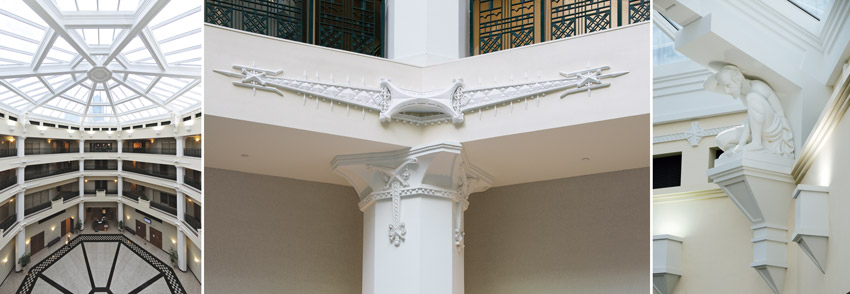
Glass fiber-reinforced gypsum (GRG) castings provide great design flexibility and opportunity for details, as shown here at the St. James Building in Jacksonville, Florida.
Once the GRG castings are sent to the project site, they are usually quite easy to install since they have been made specifically to fit in selected locations on walls or ceilings. Adhesive or mechanical fastening, or a combination, can be employed as appropriate to secure the castings permanently in place. Like plaster products, the standard GRG surface finish is an unfinished, paint grade surface. That means they can be field painted or coated to achieve any desired color or texture. That can include smooth, continuous looks or specialty finishes to replicate the look of natural materials such as wood, stone, or metals, but all at a lower cost than using those actual materials.
In addition to decorative purposes, GRG has been used for other reasons. In a general interior lighting scheme, it can be formed into light coves or other features to direct, diffuse, or disperse light in an interior space. In spaces that need acoustic treatments to achieve a desired reverberation rate, the density can be adjusted by customizing the thickness to 1⁄2 inch or 3⁄4 inch instead of the standard 3⁄16 inch. Acousticians are increasingly recognizing this capability and finding it a good material with which to work.
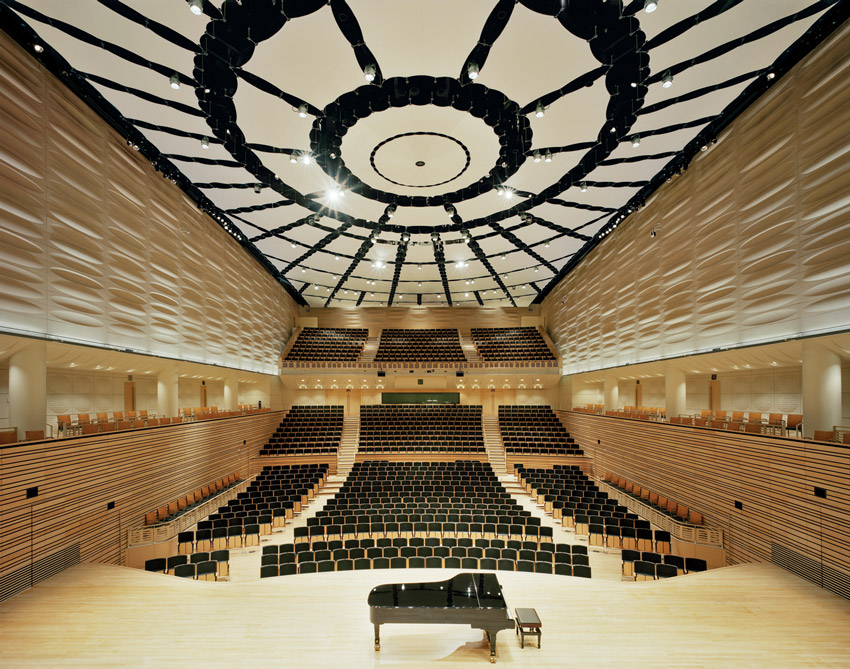
GRG has become recognized for providing desirable acoustic properties related to reverberation, such as in this auditorium at Experimental Media and Performing Arts Center in Troy, New York.
Since GRG architectural castings are gypsum based, they are very low maintenance. This makes them well suited for many typical applications on interior ceilings and walls, such as decorative ceiling and wall panels, coffers, domes, light coves, vaults, and moldings. They can also be used as decorative column covers over structural steel columns in many cases. Virtually any interior spot that needs some added detail or design features can likely be addressed by using GRG architectural castings.
Glass Fiber-Reinforced Concrete (GFRC)
The use of precast concrete features on building exteriors such as cornices, copings, and similar items has been common for some time, particularly on masonry buildings. Using glass fiber-reinforced concrete (GFRC) instead of conventional precast moves the use of this type of architectural casting into new and rather creative possibilities. Since GFRC is a lightweight portland cement composite material that is reinforced with glass fibers, it is an economical and more diverse alternative to precast concrete. GFRC has been used as an architectural building material in North America since the 1970s, though its use in Eastern Europe extends back to the 1940s. It is typically an exterior product but can also be used for interior applications.
The specific makeup of GFRC materials consist of portland cement, sand, aggregates, alkali-resistant fiber, polymer, additives, and water. Since it is concrete based, it also readily achieves Class A fire performance per ASTM E84. Although it is typically cast as a ½-inch material, the reinforced concrete makeup means that it is durable in that it will not rot, rust, or suffer unduly from abuse or vandalism. It readily can withstand weather exposure over time. While these are all appropriate and desirable characteristics for exterior use, it is also safe for interior use since the finished product is odorless and emission free. In terms of structural impact, GFRC castings typically weigh only 6–8+ pounds per square foot, which can impose less dead load on a building than conventional precast concrete. (Note that weight between different castings vary depending on details, thickness, reinforcement, etc.)
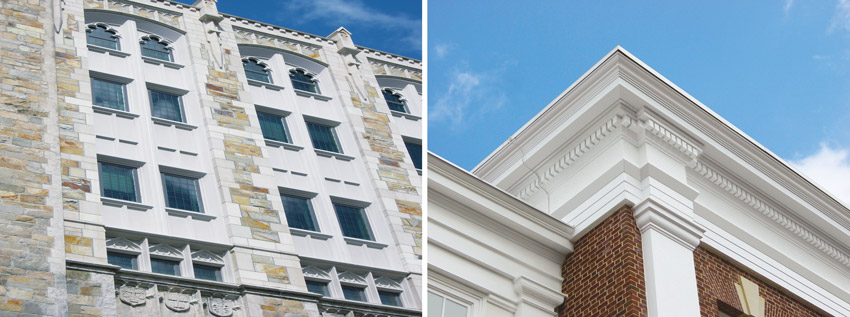
Glass fiber-reinforced concrete (GFRC) can be cast into a variety of exterior shapes, including entire wall panels or cornice/frieze details across large sections of a facade.
Other appealing characteristics of GFRC include its complete design flexibility. It can be cast into virtually any shape or compound curve and has even been used to create ornamental figures, gargoyles, etc. Since they are custom fabricated, they can be engineered to reduce installation time and the associated labor costs. Finally, the concrete base of the material means that it is very low maintenance with durability enhanced by the addition of glass fibers.
GFRC castings are used for a wide range of component parts and elements of building facades and interiors. It is worth noting, though, that traditional building materials often require multiple, individual parts to achieve a desired outcome. By contrast, GFRC can be cast in larger panels that incorporate the look of all of those smaller parts, thus offering “part consolidation.” This aspect minimizes the actual number of pieces sent to the job site and reduces site labor accordingly.
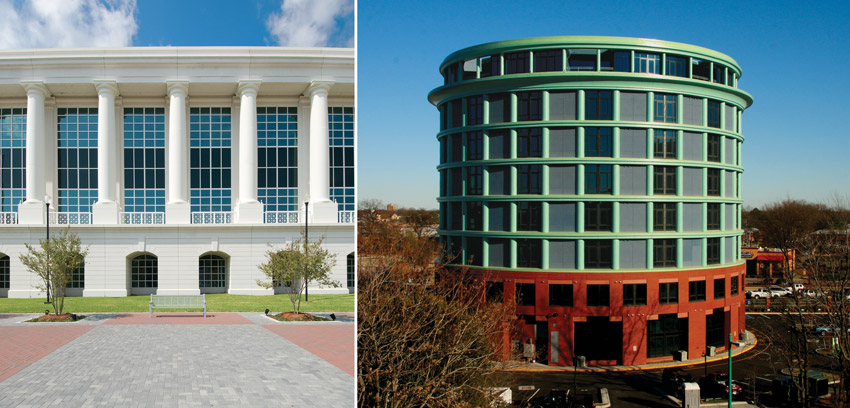
GFRC can produce decorative columns, such as the traditional ones shown on the left and the paint-grade contemporary ones shown on the right.
All of these attributes make GFRC very appealing for building facades by providing 21st century solutions for things like cornices, friezes, pediments, and even cladding such as cast wall panels or rainscreens. For facades that seek decorative columns, those too can be made with GFRC in exactly the style, proportion, and size needed. They can also be cast for architectural details such as finials, panels, and cornices. This concept can be carried a step further with statue-like figures being cast for outdoor use at entries, along rooflines, or in landscaped areas. Of course, while all of these uses make sense for new construction, they can also be a major benefit to historic restoration projects where there is a need to match existing concrete or stone items on a facade in an accurate but cost-effective manner. Overall, GFRC provides the design flexibility and performance characteristics needed for many different types for building project conditions.
Glass Fiber-Reinforced Polyester Resin (FRP)
FRP is used for a lot of different purposes from recreational equipment like boats to building products such as floor gratings and wall panels. It is also a great material to use for architectural castings where lightweight, economical, and impact-resistant factors come into play. As such, it is a common choice for applications requiring weather resistance and durability for exteriors.
Glass fiber-reinforced polyester resin (FRP) is a composite consisting of gel coat, polyester resin, and glass fibers. Even though it contains polyester, it can be formulated to meet fire-performance requirements limiting the flame spread index to 25 or less per ASTM E84.
FRP architectural castings are specifically intended for exterior use and bring a number of compelling characteristics. Like the other materials we have looked at, it offers great design flexibility and can be cast into virtually any shape or compound curve. It is lighter in weight than concrete-based castings, coming in closer to gypsum-based castings at around only 2–3+ pounds per square foot depending on the shape and reinforcement details. This lighter weight and customizing ability help make it very easy to install using some conventional anchoring systems. Once in place, the durable and proven track record of FRP makes it very low maintenance. It is known for retaining its shape and beauty over time in a full range of weather conditions.
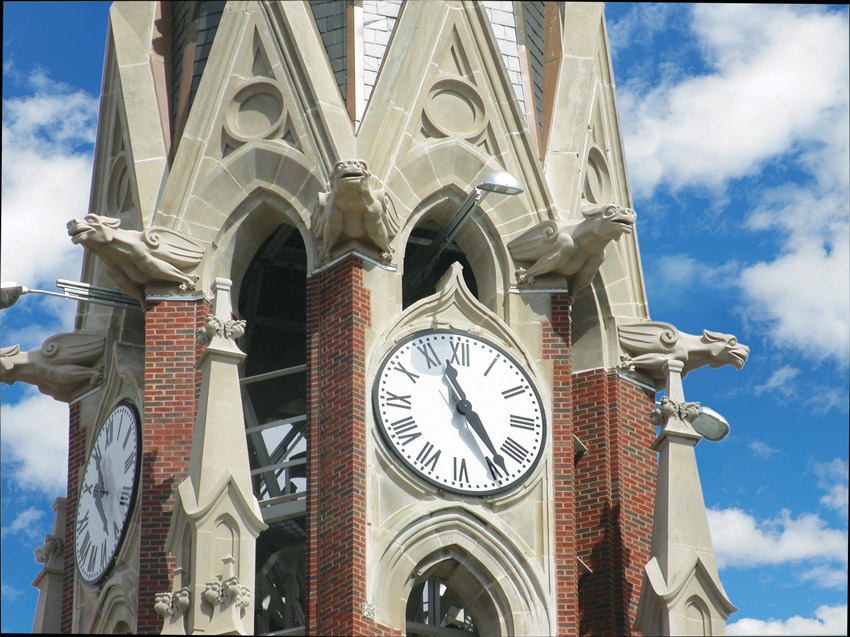
Glass fiber-reinforced polyester resin (FRP) is used on exteriors to create a variety of details, such as the gargoyles shown here.
The surface finish of FRP can be supplied in paint grade for field finishing or prefinished in the factory. In addition to smooth surface appearances, it can also be textured and painted to simulate stone, wood, or steel. That makes it a very versatile choice since it can end up in virtually any color, look like many different types of materials, and be a key component of any type of exterior design, whether traditional or contemporary.
Some of the typical uses of FRP architectural castings include facade elements such as cornices, panels, rainscreens, and decorative elements. They have also been used for specialty items like decorative columns, domes, and cupolas. Similarly, they have been formed as features such as planters, fountains, and even signage for buildings. In all, they offer a very versatile option that is ripe for imaginative use.
Cast Stone/Interior Molded Stone
For interior detailing, there is an additional option beyond GRG and GFRC. In some cases, particularly where a stone appearance is being sought, cast stone architectural castings are an economical and flexible alternative. They are ideally suited for interior castings that replicate the look of natural stone but with the ability to be cast into virtually any shape.
Cast stone is an interior molded stone (IMS) composite consisting of alpha gypsum cement, pigment, aggregate, water, and polymers. Since it is a gypsum-based product, it readily achieves Class A fire performance per ASTM E84, meaning it is suitable for large and small areas for interior walls and ceilings in commercial and institutional buildings. Since it can be cast into any shape or compound curve, it offers a great deal of design flexibility with a virtually unlimited range of custom casting shapes and sizes being possible. Further, since cast stone typically weighs only 2–5+ pounds per square foot depending on the shape and the reinforcement used, it can be readily attached to conventional wall and ceiling systems without any special construction needed.
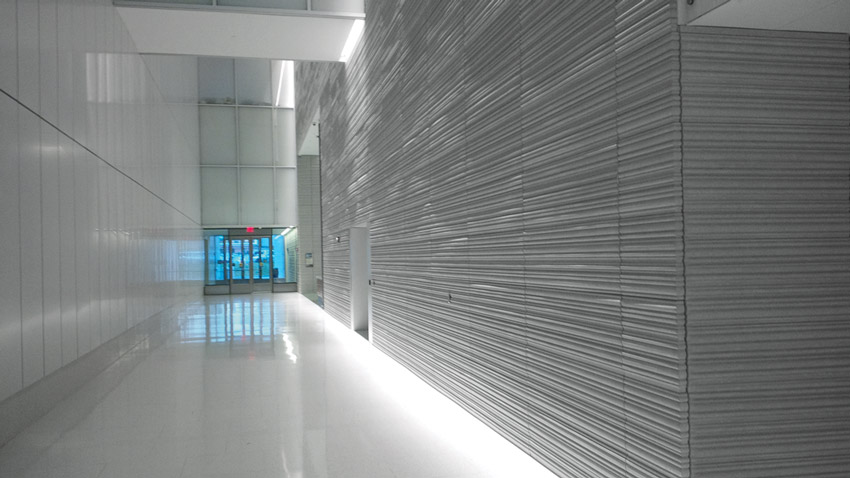
Cast stone can be formed into decorative features or fashioned to create distinctive full-height wall panels as shown here.
The finished surface of cast stone is available in standard colors ranging from natural greys, tans, creams, and white as well as some greens and blues. It can also be cast in custom colors as may be desired. Cast stone is typically sealed with a clear satin coating for a durable, easy-to-clean finish. Since it is inherently durable to begin with, based on its material makeup, it is a long-lasting and very low-maintenance addition to interior designs.
Based on all of these attributes, cast stone is commonly used for a variety of interior treatments. It works very well as a cladding material for interior retail facades. For featured areas, cast stone can be made to form pediments, cornices, door surrounds, and trim, either as individual castings or integrated directly into larger wall and flat panels. It can also be used to form coverings over steel columns to provide the look of stone columns without the expense or the weight. The same is true with demising piers or other items that would benefit from a different appearance. For some specific details, cast stone can also be considered for things like fireplace surrounds and even signage.
Overall, if there is a need or a desire for a stone appearance for interiors, cast stone castings may provide the needed look with less weight, more control, and more cost efficiency.
Green Building Aspects of Architectural Castings
All building products are routinely reviewed by architects and others for sustainability traits and quite often for how they can help contribute to certification under the LEED green building program or others. Depending on the quantity and size of architectural castings used on a project, the green building contribution could range from minor to very significant. Hence it is worth recognizing the following green building attributes.
Materials and Resources
Architectural castings of all types are engineered to use materials and resources very efficiently. Most are based on combining natural materials in very controlled manners to minimize waste during their manufacture. Further, since parts are supplied to suit field measurements and conditions, there is little or no job-site cutting resulting in no on-site waste. Shipping of the products involves crating on wood pallets and 2-by-4s that can be easily reused or recycled.
From a product life-cycle standpoint, new raw materials are typically used for most castings, but they tend to use a lot less material when compared to full, traditional concrete, stone, or plaster items. Nonetheless, the nature of the raw materials used usually dictates that they are sourced locally and not shipped long distances, helping to reduce the impact of embedded energy in those materials. For recycled content, some post-industrial fillers can be used in castings in certain cases to make the overall impact a bit less as well. The process of forming the castings does not involve any high-heat process so the energy use and impact during fabrication is very controllable. The durability of the castings speaks to their long service life, and their material makeup makes them very suitable for salvage and reuse or recycling at the end of that service life.

The materials used in architectural castings help determine their overall life-cycle attributes contributing to green and sustainable design.
It is worth pointing out the potential positive ripple effect of using architectural castings as an innovation in design in this category. We have already mentioned that castings can use less material than their traditional counterparts, which is significant unto itself. Taking that a step further, the weight of architectural castings is less than solid concrete, stone, or similar materials that they replace. That reduced weight means there is less dead load acting on the structural system, which may mean that steel or other structural framing can be reduced, thus decreasing the amount of material in that framing. By extension, less weight and lighter steel means the foundation system does not need to carry as much weight and can be reduced accordingly. Of course, all of this is very project specific and depends on what the castings are being compared to in terms of traditional construction and materials. However, it would seem that a case can be made that the material benefits go beyond just the castings themselves.
Indoor Environmental Quality
Healthy indoor environments are paramount among many green building rating systems, including LEED, the WELL Building Standard, and The Living Building Challenge. In particular, the use of building materials inside of buildings that do not contain or emit substances that are harmful to human health has been a major motivation behind the creation of these standards and criteria. Their refinement and sophistication have helped define a good-quality, healthy indoor environment.
Architectural castings play well into this situation in that they can be completely prefinished with low-emitting materials that do not contain any urea-formaldehyde or volatile organic compounds (VOCs)—some of the main substances of concern for a healthy indoor environment. Since castings can be prefinished in this way, then no paints, coatings, adhesives, or sealants are needed in some cases. If paint-grade castings are selected, then they will work quite well with no or low-VOC paint and can still help contribute to this category.
Cost Considerations
All discussions of building products and systems eventually get around to the cost of using them. More specifically, they usually focus on comparing the cost of a particular approach to some other alternatives to determine whether or not the project is being done efficiently and will stay within budget. All of those factors can vary widely from project to project, but we can look at some general comparisons, factors that influence price, and the long-term cost beyond the initial cost of using architectural castings.
In general, GFRC is less costly to use than traditional precast concrete because of its thinner profile and other characteristics. Both FRP and GFRC are lighter in weight than precast concrete, which contributes to their overall cost efficiencies. Architectural castings, when used as column covers or surrounds, are generally less expensive than metal surrounds. Beyond these specific comparisons, there are also some general cost saving items that need to be considered. First is the fact that architectural castings can provide a consolidated product (i.e., a single panel with multiple features that would have otherwise been made up of multiple parts), which can reduce labor and installation time on the jobsite. Second, they provide capabilities within the products for some needed traits such as fire resistance, acoustical performance, and prefinishing. In some cases, those traits are superior to some of the more conventional alternatives or to other similar off-the-shelf materials. All of these integrated characteristics eliminates the need for other products to be added.
When designing custom architectural castings into a building, the cost will be directly affected by the number of castings made per mold. Since the cost to make the mold is similar, whether you have one or 50 castings, the mold cost can be thought of as being spread equally over the total number of castings made. Hence if one mold is made and only one casting is fabricated from it, then that one casting will absorb all of the cost of the mold, making it comparatively very expensive. On the other hand if that same mold is used to create up to 10 or more castings, the mold cost is spread across them, and the cost will become more practical. The optimal condition, of course, is to spread the mold cost out over as many castings as possible, say 100 or more, which reduces the cost per casting considerably.

The number of castings made in a particular mold will directly influence the ultimate cost of the castings since the mold cost will be spread out equally across them.
Another consideration in the cost of architectural castings is the degree of detail involved in the cast elements. Keep in mind first that, if there is little to no detail required in the items, meaning they are all flat surfaces, then it can probably be done more economically using gypsum board or other materials. When there is more detail being called for in one or more panels, that is when it makes sense to consider a casting. The degree of detailing (i.e., relief items, decorative accents, artistic shapes, etc.) will have somewhat of an impact, but since the mold is fabricated by computerized techniques, the overall size and shape may be more of a cost driver. The casting needs to be workable too, such that the type of detail doesn’t interfere with removing it from the mold, which could create a more expensive level of difficulty in fabricating.
When it comes to the long-term cost of architectural castings, we have seen that they are very durable and need little, if any, maintenance. That means they can cost less than other products in cleaning and building operation costs over the life of the building. Related to that, most notably on exterior building applications, continuous castings made from large panels is a means to reduce the number of joints and seams. That can dramatically reduce the opportunities for weather to penetrate into the wall system and cause corrosion, damage, or other problems. Avoiding those problems to begin with is always more cost effective than having to repair, maintain, or reseal, weak areas on a facade.
Conclusion
We have explored the range of common architectural castings for both interior and exterior installations and looked at the characteristics of the four most common ones, namely GRG, GFRC, FRP, and cast stone. It has become clear that dramatic or sublime architectural details can be created to enhance an overall design and to address more practical considerations, such as fire performance, acoustics, and durability. Their makeup of predominantly natural materials and their resulting lighter weight contribute not only to easier installation but also toward green and sustainable design and construction. Finally, we have looked at the cost considerations and favorable economics of using architectural castings in buildings. For ceilings, walls, features, accents, details, and other building elements, architectural castings can be a very satisfying and long-lasting choice for all types of commercial and institutional buildings.
Peter J. Arsenault, FAIA, NCARB, LEED AP,
is a nationally known architect, consultant, continuing education presenter, and prolific author advancing building performance through better design. www.pjaarch.com, www.linkedin.com/in/pjaarch






























